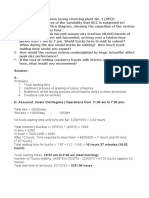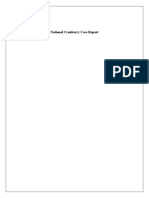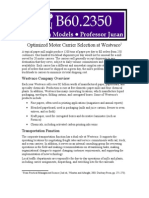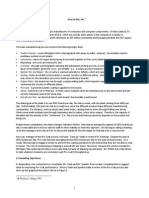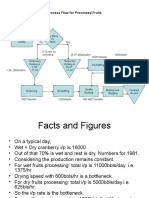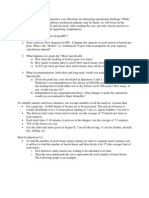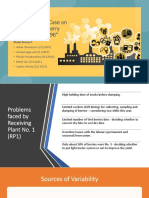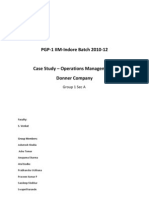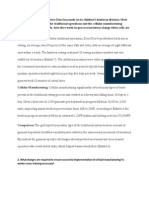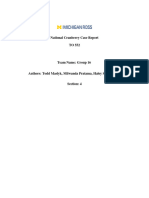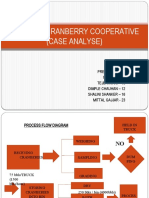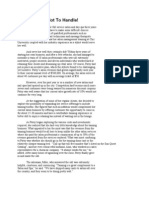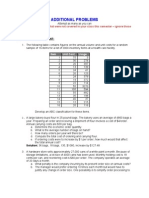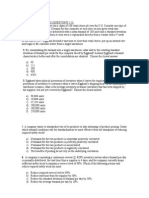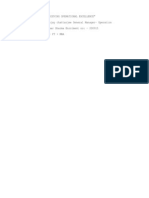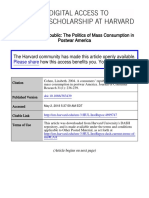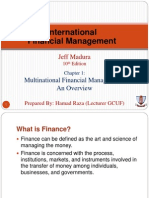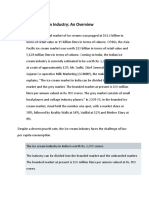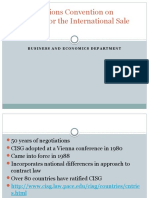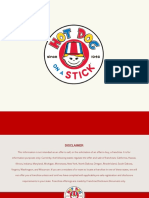Problem Set
Problem Set
Uploaded by
jarjonaeCopyright:
Available Formats
Problem Set
Problem Set
Uploaded by
jarjonaeOriginal Description:
Copyright
Available Formats
Share this document
Did you find this document useful?
Is this content inappropriate?
Copyright:
Available Formats
Problem Set
Problem Set
Uploaded by
jarjonaeCopyright:
Available Formats
MSIS 511 Operations Management Problem Set 1
1. Two types of cars, X and Y were produced by a car manufacturer in 1997. Quantities sold, price per unit and labor hours follow. What is the labor productivity for each car? Explain the problem(s) associated with the labor productivity. Car X 4000 8000 12 20,000 Car Y 6000 9500 14 30,000
Units Sold Unit Revenue ($) Labor Wages/hr. ($) Labor (Hours)
2. Calculate human and capital partial and multi-factor productivity measures for the following data if output is measured as work in process plus finished goods. Output($) Finished Goods Work In Process Dividends Input($) Human Material Capital Energy Other Expenses 3,000 153 10,000 540 1,500 10,000 2,500 1,000
3. A proposal for process improvement is being considered by a company, which reduces the processing time for each, unit so that the output is increased by 25% with less material but one additional worker is required. Under the current process, five workers could produce 60 units per hour. Labor costs are $12 per hour and material input is $16 per unit. For the new process, material will be $14 per unit. Finished units sell for $31 each. The output of the process contains 10% defectives. Defectives are returned and exchanged with a new unit. Furthermore, there is an additional cost of processing/handling charge of $15 for every defective unit sold incurred by the company.
a) Define the components for calculating the total productivity and find the percentage increase/decrease in total productivity associated with the proposed process improvement. b) Suppose that, in addition to improving the current process, the company is also considering the addition of a final inspection station. The inspection station requires one worker and requires a one time $20,000 investment in machinery. The cost of repairing a defective unit at the final assembly is $10 and the inspector can inspect a maximum of 100 units per hour. Should an inspection station be opened? (In your analysis, assume that investments continue in perpetuity, the nominal cost of capital is 20% per year with daily compounding and that the company uses 360 calendar days for one year and an eight hour shift per day) c) One of the managers insists that instead of inspection as a way of correcting the quality problems, the company should explore improving the rate of defects through training programs. She points out that a typical training program would cost the company a total of $30,000 (a one time cost). What should be the minimum improvement in the rate of defects to make this alternative economically viable?
d) Suppose that the inspector can process at most 50 units per hour in b). How would this impact the decisions in (a) and (b)? (Assume that units will not be sold to customers unless inspected) 4. A hospital emergency room (ER) is currently organized so that all patients register through an initial check-in process. At his or her turn, each patient is seen by a doctor and then exits the process either with a prescription or with admission to the hospital. Currently, 50 people per hour arrive to the ER, 10% of whom are admitted to the hospital. On average 30 people are waiting to be registered and 40 are registered waiting to see a doctor. The registration process takes an average of 2 minutes per patient. Among patients who receive prescriptions, average time spent with the doctor is 5 minutes. Among those admitted to the hospital, average time is 30 minutes. On average, how long does a patient stay in the ER? On average, how many patients are in the ER? (Assume that we have a Stable process throughout).
MSIS 511 Operations Management Problem Set 2
1. Burrito Master is a new fast-food franchise that is opening up nationwide. Burrito Master has been successful in automating burrito production for its drive-up fast food establishments. The Burrito-Maker 9000 requires a constant 45 seconds to produce a burrito. It has been estimated that customers will arrive at the drive-up window according to a Poisson distribution at an average of 1 every 50 seconds. Find: a) The average time a customer spends in the system, b) The average number of cars waiting in the drive-up queue and the average number of cars in the system. 2. Big Jacks drive-through hamburger is planning to build another stand at a new location and must decide how much land to lease to optimize returns. Leased space for cars will cost $1000 per year per space. Big Jack is aware of the competitive nature of the business and knows that if his drive-in is full, customers go elsewhere. The location under construction has a potential arrival rate of 30 per hour (Poisson). Customer orders are filled at an average rate of 40 per hour and are exponentially distributed. The average profit on each transaction is $0.6, and the stand is open from noon to midnight every day. How many spaces should be leased? 3. The law firm of LD and Associates specializes in the practice of waste disposal law. Data regarding the cases received in a year and the times to complete a case was recently compiled. Suppose that the firm works on one case at a time. Cases are received according to a Poisson distribution with a mean of one case every 30 days. The data on the time on the completion times of the last 10 cases are 27,26,26,25,27,24,27,23,22 and 23. Assuming that cases are handled one at a time on a first come first served basis, determine the number of clients waiting for their case to be processed and the average time a client has to wait until his/her case is completed (wait in queue plus service). 4. A beverage store has determined that it is economically feasible to add a drive-in window, with space for two cars: one at the window and one waiting. The owner wants to know whether more waiting space should be leased. Cars arrive according to a Poisson distribution at a rate of eight per hour. Transactions average 10 per hour, and the times are exponentially distributed. Each transaction makes $1 profit. The owner plans to be open 12 hours per day, 6 days a week, 52 weeks a year. Additional spaces cost $2000 per year to lease. How many spaces is it worthwhile to lease.
5. At the U.S./Canadian border inspection station, vehicles arrive at a rate of 10 per minute according to a Poisson distribution. For simplicity, assume that there is only one lane and one inspector who can inspect vehicles at an average rate of 12 per minute. Inspection times are exponentially distributed. a) What is the average length of the waiting times? b) What is the average time a vehicle must wait to get through the system? c) What is the utilization rate of the inspector? d) What is the probability that when you arrive, there will be three or more vehicles ahead of you? 6. During the campus spring fling, the bumper car amusement attraction has a problem of cars becoming disabled and in need of repair. Repair personnel can be hired at a rate of $5 per hour, but only work as one team. Thus, if one person is hired, s/he works alone; two or three people work together on the same car. One repairperson can repair cars in an average time of 30 minutes. Two repair people take 20 minutes and three take 15 minutes. Assume that repair times are exponentially distributed. While these cars are down, lost income is $20 per hour. Cars breakdown according to a Poisson distribution at an average rate of two per hour. How many repair people should be hired.
7. During slow hours, a certain branch of a bank uses three tellers, each of whom can process customers at a rate of 1.26 per minute. The average time between arrivals of customers is 25 seconds. Assuming that arrivals follow a Poisson distribution and the service times follow an exponential distribution: a) Find the system utilization b) Find the average number of customers in line c) Suppose the hourly wage for a teller is $6 and the bank claims to pay $2 for each minute of waiting in the line to every customer. Find the optimal number of clerks which minimizes the expected total cost per time period. 8. Arrivals to the express line of a grocery store follow a Poisson distribution with a mean rate of 20 per hour. Suppose that each transaction follows an exponential distribution with a mean of 2 minutes. In order to promote quality service, the grocery store claims to pay $5 to every customer who waits more than 5 minutes in the line. If the cost of opening each extra express line, which will split the arrival rates proportionally, is $7 an hour, how many express lines should be opened.
MSIS 511 Operations Management Problem Set 3
1. A local machine shop buys hex nuts and molly screws from the same supplier. The hex nuts cost 15 cents each and the molly screws cost 38 cents each. A setup cost of $100 is assumed for all orders. Holding costs are based on a 25% annual interest rate. The shop uses an average of 20,000 hex nuts and 14,000 molly screws annually. a) Determine the optimal order quantity of the hex nuts, the molly screws, and the total aggregated annual cost incurred if both items are ordered separately.
If both items are ordered and received simultaneously, a single setup cost of $100 is incurred. Find the optimal order quantities of each product and the total aggregated annual cost incurred if: b) Both items are ordered when the hex nuts would normally be ordered. c) Both items are ordered when the molly screws would normally be ordered.
2. Rex manufacturing purchases a printed circuit board for use in its automatic, computerized, robot bartender. The manufacturing facility has placed the following monthly demands on purchased goods inventory during the past year.
Month Demand
1 205
2 193
3 197
4 220
5 202
6 226
7 179
8 197
9 186
10 202
11 179
12 214
This demand schedule can be assumed to be random, to follow a normal distribution, and to be representative of what will occur in the future. Rex estimates that a fixed cost of $300 is incurred each time an order is placed for the boards, and that the inventory holding cost is about 20% per year of the value of inventory. Each board has an estimated value of $192 at the point of storage. The leadtime on purchase orders is (1/5) month. (a) What is the EOQ? (b) What is the safety stock required to assure the management that the chance of a stockout in a cycle is no more than 1%? (c) What is the reorder level?
3. The KAB Corporation's daily demand for item XYZ is normally distributed with a mean of 50 and a standard deviation of 4. The replenishment leadtime is a constant 10 days. The cost of placing an order is $40 and the unit holding cost per year is $3. KAB operates 365 days per year. a) Compute the optimal order quantity. b) What is the reorder point if a 90% against stockouts per cycle is desired? c) If the reorder point is set at 530, what is the chance of not having stockouts in an order cycle? d) Suppose the management uses an order quantity of 1,000 units. What is the reorder point if an average of one stockout every 300 days is desired? 4. The home appliance department of a large department store is using inventory models to control the replenishment of a particular model of Microwave ovens. The store sells an average of 25 ovens each week. Weekly demand follows a normal distribution with standard deviation of 7. The store pays $100 for each oven. Fixed costs of replenishment are $28. The accounting department recommends a 20% annual interest rate for the cost of capital. Assume that the leadtime is one week (4 weeks each month and 48 weeks each year). a) What is the EOQ? b) What is the reorder point if the maximum chance of 9% of having stockouts in a cycle is allowed? c) What is the reorder point if an average of 2 stockouts every five years is desired? d) What is the reorder point if the average time between stockouts is targeted at 75 weeks? e) What is the reorder point if a fill rate of 99% is desired? 5. DAT, Inc. produces digital audio-tapes to be used in the consumer audio division. The following shows a sample from the inventory records:
Product Average demand/Month Unit Price ($)
1 700 6
2 200 4
3 4 2000 1100 12 20
5 4000 21
6 100 10
7 3000 2
8 2500 1
9 500 10
10 1000 2
Develop an ABC Classification for these items.
MSIS 511 Operations Management Problem Set 4 1. Irwins sells a particular model of fan, with most sales being made in the summer months. Irwins makes a one-time purchase of the fans prior to each summer season at $40 each. It sells each fan for $70. Any unsold fan at the end of the summer season are marked down to $29 and sold in the special fall sale. Virtually all marked down fans are sold. The following is number of sales of fans during the past 10 summers: 30,50,30,60,10,40,30,30,20,40. a) Estimate the mean and the standard deviation of demand for the fans each summer. b) Assuming that demand each summer follows a normal distribution, determine the optimal number of fans to buy prior to each summer season. c) What will be the number of fans to purchase if Irwins desires to have a 90% chance of not running out of stock during a summer season? 2. James Long, the owner of Longs Inc., is a distributor of one size fit all T-shirts. Tshirts are purchased from the manufacturer in Asia before the beginning of the season and are stocked and sold to resellers. At the end of the season, unsold T-shirts are sold to the local discount stores at a deep discount. Consider the following situation regarding a Tshirt, which comes in two popular colors, red and green. T-shirt (color) Red Green Average demand 10,000 15,000 Std. dev. of demand 3000 4000 Unit Selling Price ($) 15 15 Unit Purchasing Cost ($) 10 10 Unit Holding Cost (for the entire season) 0.5 0.5 Unit Salvage Price ($) 8 8
Assuming that demand for T-shirts are Normal, a) Find the optimal quantities to be ordered for each T-shirt color and the overall average total cost for the season associated with this operation.
Instead of ordering the T-shirts with colors to the Asian Manufacturer and then stocking them at the warehouse, James is considering ordering white T-shirts to the manufacturer and complete dying the T-shirts locally as needed. This way, only white T-shirts will be stocked as dying can be completed expeditiously in no time. Each white T-shirt will cost $6. Unsold white T-shirts will be salvaged at the end of the season at $4.5. In addition,
the unit holding cost of stocking white a T-shirt for the season is $0.3. Finally, the dying cost will be $5 per T-shirt. b) Which supply chain concept(s) discussed in class is (are) being considered here? c) Assuming that the demand for Red and Green T-shirts are independent, calculate the optimal order quantity for the white T-shirts, the average total cost for the season associated with this operation. Based on your analysis, should James take this action?
You might also like
- Solution Manual For Essential Mathematics For Economics and Business Teresa Bradley Paul Patton PDFDocument5 pagesSolution Manual For Essential Mathematics For Economics and Business Teresa Bradley Paul Patton PDFKAFIL KANWER0% (3)
- A Nut Case Assignment 2Document2 pagesA Nut Case Assignment 2Priya Murmu33% (3)
- Assignment #1: Merton Truck Company Question 1: What Is The Contribution Toward Fixed Costs If Only Model 101 Is Built?Document9 pagesAssignment #1: Merton Truck Company Question 1: What Is The Contribution Toward Fixed Costs If Only Model 101 Is Built?TerryNo ratings yet
- Valley Forge Problem SoutionDocument5 pagesValley Forge Problem SoutionSashi Velnati0% (1)
- Kim Opim An Enthusiastic Student Is On Her Flight OverDocument2 pagesKim Opim An Enthusiastic Student Is On Her Flight OverAmit Pandey0% (1)
- Opre6302 Operations Management Assignment #3Document3 pagesOpre6302 Operations Management Assignment #3NingFu0% (3)
- OM WordDocument3 pagesOM WordpulakitNo ratings yet
- Ch7 9 SolutionDocument16 pagesCh7 9 Solutionluxmean50% (2)
- National Cranberry Case ReportDocument7 pagesNational Cranberry Case ReportVamshi Preetham BogaNo ratings yet
- 04 WestvacoDocument4 pages04 Westvacoelvarg09No ratings yet
- Flip Case StudyDocument8 pagesFlip Case StudyAlisson VelapatiñoNo ratings yet
- A) What Are The Information Flows Within The Donner Factory. Trace An Order As It Moves From The Originating Customer To CompletionDocument6 pagesA) What Are The Information Flows Within The Donner Factory. Trace An Order As It Moves From The Originating Customer To CompletionAKRITI GUPTANo ratings yet
- Quiz II SCM AnsDocument3 pagesQuiz II SCM AnsCostina Luc0% (1)
- Pro-Coat Case StudyDocument6 pagesPro-Coat Case StudyKaranPahawaNo ratings yet
- OM Case Write-UpDocument2 pagesOM Case Write-UpTushar SinhaNo ratings yet
- KsebBill 1165411013809Document1 pageKsebBill 1165411013809Jio CpyNo ratings yet
- Chapter 4Document30 pagesChapter 4Dhanny MiharjaNo ratings yet
- Assignment UnileverDocument33 pagesAssignment UnileverAnonymous ZiivIL100% (2)
- Breakeven and EOQ Exercises (With Answers)Document6 pagesBreakeven and EOQ Exercises (With Answers)Charlene ChorNo ratings yet
- OPIM101 - Spring 2012 - Extra Study Problems With Solutions PDFDocument17 pagesOPIM101 - Spring 2012 - Extra Study Problems With Solutions PDFjoe91bmw100% (1)
- National Cranberry Cooperative 1981Document10 pagesNational Cranberry Cooperative 1981Nicole Dorado0% (2)
- OM1 Practice Exam2Document5 pagesOM1 Practice Exam2nonysinghNo ratings yet
- National CranberryDocument2 pagesNational CranberryNripesh PokhrelNo ratings yet
- National Cranberry PDFDocument2 pagesNational Cranberry PDFVarun Chand0% (1)
- SectionA Group8 Manzana InsuranceDocument19 pagesSectionA Group8 Manzana Insurancekarthikmaddula007_66No ratings yet
- WG 1 Sep7 Problem SetDocument2 pagesWG 1 Sep7 Problem SetJotham HensenNo ratings yet
- Blitz Process FlowDocument6 pagesBlitz Process FlowPrashant DhayalNo ratings yet
- National Cranberry Cooperative Case Answer 1Document6 pagesNational Cranberry Cooperative Case Answer 1PRITEENo ratings yet
- National Cranberry Cooperative - 11BM60070Document3 pagesNational Cranberry Cooperative - 11BM60070Neelesh KhattarNo ratings yet
- Test 1 PDFDocument7 pagesTest 1 PDFMallory Ennis0% (1)
- OM - National Cranberry - TemplateDocument3 pagesOM - National Cranberry - Templatebeta alpha gammaNo ratings yet
- Exercises On Supply Process CapacityDocument2 pagesExercises On Supply Process Capacityyahska1305100% (1)
- BCE: INC Case AnalysisDocument6 pagesBCE: INC Case AnalysisShuja Ur RahmanNo ratings yet
- Inventory Buit Up With Time Inventory Buildup at TruckDocument3 pagesInventory Buit Up With Time Inventory Buildup at TruckdfreNo ratings yet
- Study Group - 2 NCC CaseDocument7 pagesStudy Group - 2 NCC CaseAchin ChatterjeeNo ratings yet
- CRU Computer Rental Case: Aneeqa Akhtar Megha Syam Gut Murad AliDocument11 pagesCRU Computer Rental Case: Aneeqa Akhtar Megha Syam Gut Murad AliAnkit MittalNo ratings yet
- NCC-Case-Writeup-2021 - Sec D - Group D15Document9 pagesNCC-Case-Writeup-2021 - Sec D - Group D15dfreNo ratings yet
- Write Up - Case Study - Donner CompanyDocument6 pagesWrite Up - Case Study - Donner CompanyGanesh AroteNo ratings yet
- MA Session 5 PDFDocument35 pagesMA Session 5 PDFArkaprabha GhoshNo ratings yet
- Anagene Case StudyDocument1 pageAnagene Case StudySam Man0% (3)
- Managing Inventories at Alko Inc.: Case StudyDocument2 pagesManaging Inventories at Alko Inc.: Case StudyDaniel Jadi0% (2)
- Manzana Insurance: The Business ProblemDocument8 pagesManzana Insurance: The Business Problemdhirendra katiyarNo ratings yet
- Ie202 SS1Document8 pagesIe202 SS1HandeeorNo ratings yet
- What Changes Are Required To Ensure Successful Implementation of Cellular Manufacturing? Is Worker Cross-Training Necessary?Document4 pagesWhat Changes Are Required To Ensure Successful Implementation of Cellular Manufacturing? Is Worker Cross-Training Necessary?isaavedracastroNo ratings yet
- Chapter 5Document3 pagesChapter 5zixuan weiNo ratings yet
- Color ScopeDocument10 pagesColor Scopedharti_thakare100% (1)
- National Cranberry - Section 4 Group 16Document8 pagesNational Cranberry - Section 4 Group 16milwandaNo ratings yet
- Assignment 2Document3 pagesAssignment 2Sodhani AnkurNo ratings yet
- Case Case:: Colorscope, Colorscope, Inc. IncDocument4 pagesCase Case:: Colorscope, Colorscope, Inc. IncBalvinder SinghNo ratings yet
- Ejercicios SimulacionDocument7 pagesEjercicios SimulacionVictor CastroNo ratings yet
- Manzana Insurance: The Business ProblemDocument8 pagesManzana Insurance: The Business ProblemDeepti AgarwalNo ratings yet
- Guesstimate The Number of COVID Testing Kits Needed by Delhi in OctoberDocument6 pagesGuesstimate The Number of COVID Testing Kits Needed by Delhi in OctobersaiNo ratings yet
- ECN358Document3 pagesECN358reddepedoNo ratings yet
- Aggregate Planning Classroom ProblemsDocument9 pagesAggregate Planning Classroom ProblemsDarwin FishNo ratings yet
- National Cranberry Cooperative (Case Analyse)Document6 pagesNational Cranberry Cooperative (Case Analyse)Teja RaoNo ratings yet
- Line Balancing and Labor Productivity - Practice Questions: WS & ME (2020) 5 Semester IqtmDocument7 pagesLine Balancing and Labor Productivity - Practice Questions: WS & ME (2020) 5 Semester Iqtmsyed aliNo ratings yet
- HW2Document8 pagesHW2Matteo BonadiesNo ratings yet
- Case16 TooHotToHandleDocument3 pagesCase16 TooHotToHandlePenantang Doktrin Kekristenan100% (1)
- Group 5 - Section C - NCCDocument16 pagesGroup 5 - Section C - NCCNitish Raj SubarnoNo ratings yet
- AddnlprobsDocument11 pagesAddnlprobsproject44No ratings yet
- 225 Final Questions PDFDocument4 pages225 Final Questions PDFValerie PriadkinaNo ratings yet
- Comm 225: Pom, Winter 2012 - Review Questions,: Topic: Statistical Process ControlDocument4 pagesComm 225: Pom, Winter 2012 - Review Questions,: Topic: Statistical Process ControlWayli90No ratings yet
- OSDocument4 pagesOSRaja RamNo ratings yet
- 1 TutorDocument7 pages1 TutorHero StrikesNo ratings yet
- Measuring National Income and The Cost of LivingDocument70 pagesMeasuring National Income and The Cost of LivingMichelleJohnsonNo ratings yet
- Case Study MaggieDocument15 pagesCase Study MaggieAshutosh KhandelwalNo ratings yet
- Online Shoping BehaviorDocument2 pagesOnline Shoping Behaviorđà nguyễnNo ratings yet
- Company Profile: TASA Foods Pvt. LTDDocument35 pagesCompany Profile: TASA Foods Pvt. LTDsaravana saravanaNo ratings yet
- Marketing Management-Module (2/5)Document125 pagesMarketing Management-Module (2/5)gopalpatel18No ratings yet
- Historical DataDocument29 pagesHistorical DataAudrelyn Carandang ArcenalNo ratings yet
- Summer Training Project ReportDocument60 pagesSummer Training Project ReportArvind KumarNo ratings yet
- A Consumers' Republic: The Politics of Mass Consumption in Postwar AmericaDocument5 pagesA Consumers' Republic: The Politics of Mass Consumption in Postwar AmericaRicky ThomasNo ratings yet
- Practice - 1Q SolutionsDocument7 pagesPractice - 1Q SolutionsAshish RanaNo ratings yet
- Nature of Strategic Management (Summary)Document4 pagesNature of Strategic Management (Summary)Jeany0% (1)
- Opm 530 GroupDocument18 pagesOpm 530 GroupMuhammad Adib0% (1)
- Love Axe Aur DhokaDocument6 pagesLove Axe Aur DhokaAnant RastogiNo ratings yet
- Mulitinational Financial Management by Jeff Mudra An OverviewDocument35 pagesMulitinational Financial Management by Jeff Mudra An Overviewfahad87083% (6)
- Sales TerritoryDocument26 pagesSales TerritoryAdil AhmedNo ratings yet
- Clearon Launches ClearControl® CMIT in The US MarketDocument2 pagesClearon Launches ClearControl® CMIT in The US MarketPR.comNo ratings yet
- O2C CycleDocument15 pagesO2C Cycleyashoda_peddirajuNo ratings yet
- Conceal MarketingDocument34 pagesConceal Marketingqadris63No ratings yet
- Krispy Case StudyDocument5 pagesKrispy Case StudyRidwan Ridho PuteraNo ratings yet
- Internationalisation of The Spanish Fashion Brand Zara: Case StudyDocument18 pagesInternationalisation of The Spanish Fashion Brand Zara: Case StudyAsia CelińskaNo ratings yet
- MBAMMDocument141 pagesMBAMMPascal TirkeyNo ratings yet
- Tabel Penelitian TerdahuluDocument3 pagesTabel Penelitian TerdahuluFachrurozie AlwieNo ratings yet
- The Ice Cream Industry: An OverviewDocument37 pagesThe Ice Cream Industry: An OverviewSonali JalanNo ratings yet
- Role of IntermediariesDocument20 pagesRole of IntermediariesAkshit Baj100% (1)
- Superbrand Colgate BrochureDocument1 pageSuperbrand Colgate BrochureNabilah NadzriNo ratings yet
- United Nations Convention On The Contracts of International Sales of GoodsDocument15 pagesUnited Nations Convention On The Contracts of International Sales of GoodsDiannaNo ratings yet
- Brochure Hot Dog and StickDocument10 pagesBrochure Hot Dog and StickdavidNo ratings yet






